Jianhua Mo
Charlie
Hybrid Near/Far-Field Frequency-Dependent Beamforming via Joint Phase-Time Arrays
Jan 25, 2025Abstract:Joint phase-time arrays (JPTA) emerge as a cost-effective and energy-efficient architecture for frequency-dependent beamforming in wideband communications by utilizing both true-time delay units and phase shifters. This paper exploits the potential of JPTA to simultaneously serve multiple users in both near- and far-field regions with a single radio frequency chain. The goal is to jointly optimize JPTA-based beamforming and subband allocation to maximize overall system performance. To this end, we formulate a system utility maximization problem, including sum-rate maximization and proportional fairness as special cases. We develop a 3-step alternating optimization (AO) algorithm and an efficient deep learning (DL) method for this problem. The DL approach includes a 2-layer convolutional neural network, a 3-layer graph attention network (GAT), and a normalization module for resource and beamforming optimization. The GAT efficiently captures the interactions between resource allocation and analog beamformers. Simulation results confirm that JPTA outperforms conventional phased arrays (PA) in enhancing user rate and strikes a good balance between PA and fully-digital approach in energy efficiency. Employing a logarithmic utility function for user rates ensures greater fairness than maximizing sum-rates. Furthermore, the DL network achieves comparable performance to the AO approach, while having orders of magnitude lower computational complexity.
Joint Phase Time Array: Opportunities, Challenges and System Design Considerations
Dec 02, 2024



Abstract:This paper presents a novel approach to designing millimeter-wave (mmWave) cellular communication systems, based on joint phase time array (JPTA) radio frequency (RF) frontend architecture. JPTA architecture comprises time-delay components appended to conventional phase shifters, which offer extra degrees of freedom to be exploited for designing frequency-selective analog beams. Hence, a mmWave device equipped with JPTA can receive and transmit signals in multiple directions in a single time slot per RF chain, one direction per frequency subband, which alleviates the traditional constraint of one analog beam per transceiver chain per time slot. The utilization of subband-specific analog beams offers a new opportunity in designing mmWave systems, allowing for enhanced cell capacity and reduced pilot overhead. To understand the practical feasibility of JPTA, a few challenges and system design considerations are discussed in relation to the performance and complexity of the JPTA systems. For example, frequency-selective beam gain losses are present for the subband analog beams, e.g., up to 1 dB losses for 2 subband cases, even with the state-of-the-art JPTA delay and phase optimization methods. Despite these side effects, system-level analysis reveals that the JPTA system is capable of improving cell capacity: the 5%-tile throughput by up to 65%.
3D Beamforming Through Joint Phase-Time Arrays
Jan 01, 2024Abstract:High-frequency wide-bandwidth cellular communications over mmW and sub-THz offer the opportunity for high data rates, however, it also presents high pathloss, resulting in limited coverage. To mitigate the coverage limitations, high-gain beamforming is essential. Implementation of beamforming involves a large number of antennas, which introduces analog beam constraint, i.e., only one frequency-flat beam is generated per transceiver chain (TRx). Recently introduced joint phase-time array (JPTA) architecture, which utilizes both true time delay (TTD) units and phase shifters (PSs), alleviates analog beam constraint by creating multiple frequency-dependent beams per TRx, for scheduling multiple users at different directions in a frequency-division manner. One class of previous studies offered solutions with "rainbow" beams, which tend to allocate a small bandwidth per beam direction. Another class focused on uniform linear array (ULA) antenna architecture, whose frequency-dependent beams were designed along a single axis of either azimuth or elevation direction. In this paper, we present a novel 3D beamforming codebook design aimed at maximizing beamforming gain to steer radiation toward desired azimuth and elevation directions, as well as across sub-bands partitioned according to scheduled users' bandwidth requirements. We provide both analytical solutions and iterative algorithms to design the PSs and TTD units for a desired subband beam pattern. Through simulations of the beamforming gain, we observe that our proposed solutions outperform the state-of-the-art solutions reported elsewhere.
Joint Phase-Time Arrays: A Paradigm for Frequency-Dependent Analog Beamforming in 6G
Dec 18, 2023Abstract:Hybrid beamforming is an attractive solution to build cost-effective and energy-efficient transceivers for millimeter-wave and terahertz systems. However, conventional hybrid beamforming techniques rely on analog components that generate a frequency flat response such as phase-shifters and switches, which limits the flexibility of the achievable beam patterns. As a novel alternative, this paper proposes a new class of hybrid beamforming called Joint phase-time arrays (JPTA), that additionally use true-time delay elements in the analog beamforming to create frequency-dependent analog beams. Using as an example two important frequency-dependent beam behaviors, the numerous benefits of such flexibility are exemplified. Subsequently, the JPTA beamformer design problem to generate any desired beam behavior is formulated and near-optimal algorithms to the problem are proposed. Simulations show that the proposed algorithms can outperform heuristics solutions for JPTA beamformer update. Furthermore, it is shown that JPTA can achieve the two exemplified beam behaviors with one radio-frequency chain, while conventional hybrid beamforming requires the radio-frequency chains to scale with the number of antennas to achieve similar performance. Finally, a wide range of problems to further tap into the potential of JPTA are also listed as future directions.
* The paper is a revised version of the IEEE Access paper, that includes the full operation of Algorithms 1-3 to help curtail incorrect implementations
Beam Management with Orientation and RSRP using Deep Learning for Beyond 5G Systems
Feb 04, 2022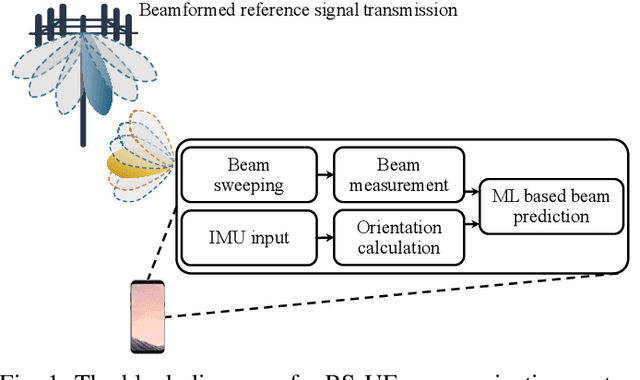
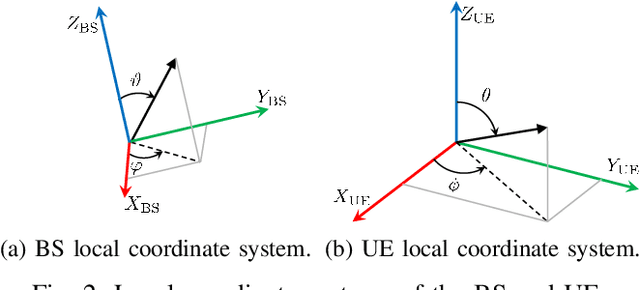

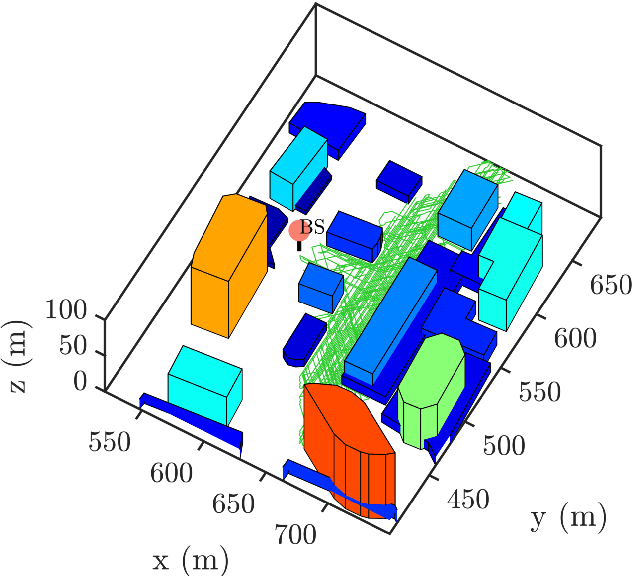
Abstract:Beam management (BM), i.e., the process of finding and maintaining a suitable transmit and receive beam pair, can be challenging, particularly in highly dynamic scenarios. Side-information, e.g., orientation, from on-board sensors can assist the user equipment (UE) BM. In this work, we use the orientation information coming from the inertial measurement unit (IMU) for effective BM. We use a data-driven strategy that fuses the reference signal received power (RSRP) with orientation information using a recurrent neural network (RNN). Simulation results show that the proposed strategy performs much better than the conventional BM and an orientation-assisted BM strategy that utilizes particle filter in another study. Specifically, the proposed data-driven strategy improves the beam-prediction accuracy up to 34% and increases mean RSRP by up to 4.2 dB when the UE orientation changes quickly.
Sub-Chain Beam for mmWave Devices: A Trade-off between Power Saving and Beam Correspondence
Dec 23, 2021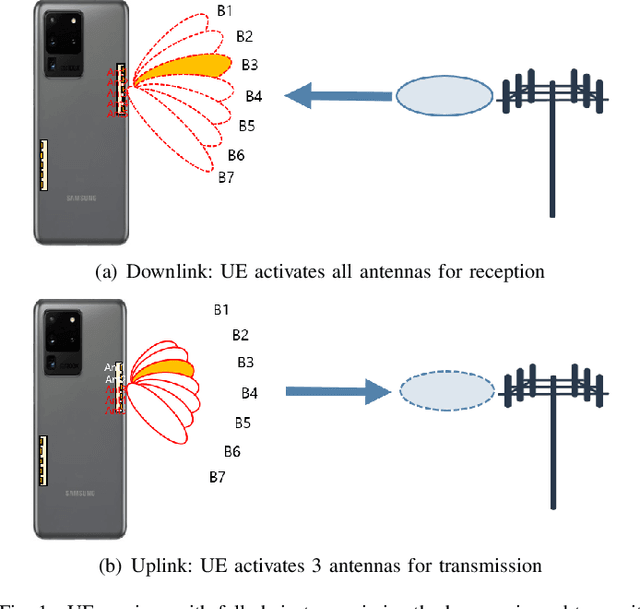
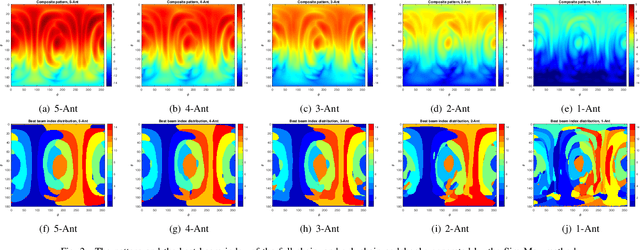
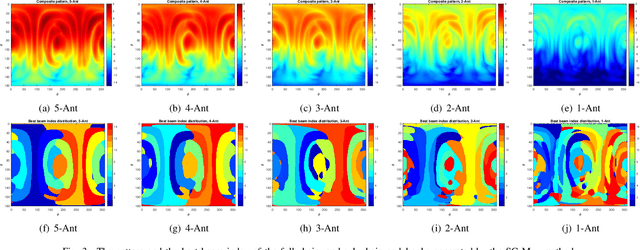
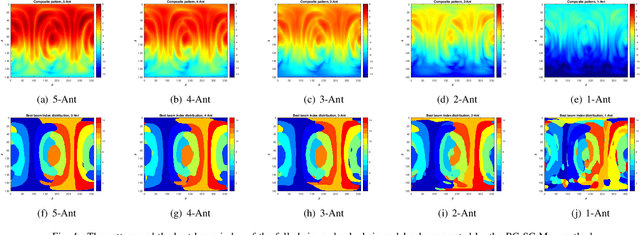
Abstract:Beam correspondence, or downlink-uplink (DL-UL) beam reciprocity, refers to the assumption that the best beams in the DL are also the best beams in the UL. This is an important assumption that allows the existing beam management framework in 5G to rely heavily on DL beam sweeping and avoid UL beam sweeping: UL beams are inferred from the measurements of the DL reference signals. Beam correspondence holds when the radio configurations are symmetric in the DL and UL. However, as mmWave technology matures, the DL and the UL face different constraints often breaking the beam correspondence. For example, power constraints may require a UE to activate only a portion of its antenna array for UL transmission, while still activating the full array for DL reception. Meanwhile, if the UL beam with sub-array, named as sub-chain beam in this paper, has a similar radiation pattern as the DL beam, the beam correspondence can still hold. This paper proposes methods for sub-chain beam codebook design to achieve a trade-off between the power saving and beam correspondence.
Learning Site-Specific Probing Beams for Fast mmWave Beam Alignment
Jul 28, 2021



Abstract:Beam alignment - the process of finding an optimal directional beam pair - is a challenging procedure crucial to millimeter wave (mmWave) communication systems. We propose a novel beam alignment method that learns a site-specific probing codebook and uses the probing codebook measurements to predict the optimal narrow beam. An end-to-end neural network (NN) architecture is designed to jointly learn the probing codebook and the beam predictor. The learned codebook consists of site-specific probing beams that can capture particular characteristics of the propagation environment. The proposed method relies on beam sweeping of the learned probing codebook, does not require additional context information, and is compatible with the beam sweeping-based beam alignment framework in 5G. Using realistic ray-tracing datasets, we demonstrate that the proposed method can achieve high beam alignment accuracy and signal-to-noise ratio (SNR) while significantly - by roughly a factor of 3 in our setting - reducing the beam sweeping complexity and latency.
 Add to Chrome
Add to Chrome Add to Firefox
Add to Firefox Add to Edge
Add to Edge